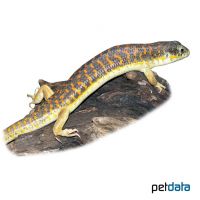Algerian Skink (Eumeces algeriensis)
| Algerian Skink Eumeces algeriensis | |
|---|---|
| Name | Algerian Skink |
| Name Lat. | Eumeces algeriensis |
| Family | Skinks |
| Family lat. | Scincidae |
| Order | Scaled Reptiles |
| Order lat. | Squamata |
| Origin | Africa |
| Habitat | Dry savanna |
| Diet | Insects, fruits |
| Humidity | 50-60 % |
| Behavior | Semi-aggressive |
| Keeping | Individual, pair |
| Care Level | Easy |
| Reproduction | Oviparous |
| Housing | Dry terrarium |
| Life Span | 15-20 years |
| Protection | No |
| Metric Units | |
| Size | 30-40 cm |
| Temperature | 23-28 °C |
| Temperature Local | 40-45 °C |
| Housing Size | 120 x 80 x 60 cm |
| US Units | |
| Size | 12"-16" |
| Temperature | 73-82 °F |
| Temperature Local | 104-113 °F |
| Housing Size | 45" x 30" x 25" |
Distribution and habitat
The distribution area of the diurnal Barbary Finches is Northwest Africa (Morocco, Algeria). They live in rocky dry savannahs overgrown with shrubs up to 1,400 m altitude and in cultivated landscapes, where they usually hide under stones at night.
Maintenance
Minimum dimensions for the terrarium, according to the size and number of animals
| 1-2 animals | 6KRL x 4KRL x 3KRL (L x W x H) |
Head-torso length (KRL) is measured on the largest animal. For each additional animal, increase the footprint by 15%. A terrarium of e.g. 120 x 80 x 60 cm is recommended, which should be placed in a quiet and vibration-free place
They need a dry terrarium with flat climbing branches, stone structures (hiding places, visual protection) and structured back and side walls (e.g. cork lining) as well as a shallow water bowl. Coarse sand or bird grit is suitable as substrate, covered with some dry leaves, pieces of bark and rubble, as well as planting for decoration (succulents, ornamental grasses, cacti, etc.). Once a day, preferably in the evening, the inside of the terrarium should be finely sprayed with water (humidity). A rain or mist system is ideal.
| Temp. day: 23-28 °C | Temp. night: 17-20 °C | Temp. local: up to 45 °C | Humidity: 50-60 |
Thermostatically controlled floor heating is recommended. The lighting duration must be 12-14 hrs. They need high light intensity and daily UV irradiation as well as sunny places with radiant heat.
Diet
The food supply consists of live insects, such as crickets, house crickets, grasshoppers, zophobas and baby mice, supplemented with sweet fruits (e.g. bananas, kiwi, pears, apples). Ready-to-eat foods for insectivorous reptiles are also frequently accepted. Wax moths should rarely be fed in very small amounts because of their large fat content. Regular addition of minerals and vitamins (e.g. by dusting the feeders) is important. Young animals should be offered food daily, adults 4-5 times a week. Drinking water must always be available
A regular and varied diet promotes health and prevents deficiency symptoms.
Reproduction and breeding
The males have a slightly broader head and a thickened tail root. A reliable sex determination is only possible by testosterone determination or endoscopy.
They are oviparous and a clutch consists of 5-20 eggs. The incubation period is 45-50 days at a temperature of 26-28 °C. However, viviparous females have also been observed. Small insects such as fruit flies, aphids, micro echinoderms, etc. are suitable as initial food.
Life expectancy can be 15-20 years.
Important
Pair keeping is sometimes difficult and only recommended in a large, richly structured terrarium. Towards other species they are very aggressive
They need hiding places and according to their need for warmth sunny places, such as stones irradiated by a spotlight. A hibernation of about 2 months, at a temperature of 15-18 °C and a lighting duration of about 8 hours is recommended. For a successful breeding the hibernation is absolutely necessary.
With fruit and honey water as food for the feeders, their quality can be upgraded.
The terrarium must have good ventilation without drafts and meet the species specific needs. Measuring devices such as thermometers, hygrometers, etc. are necessary. The lighting has to correspond to the species-specific day-night rhythm and has to be placed in such a way that the animals cannot injure themselves. The terrarium should be locked in such a way that neither unauthorized persons can open it nor the animals can escape. Contamination must be removed regularly.
Further literature can be found in your pet store.
References
Text: petdata; Image: petdata
Source: BMELV (1997): Tierschutzgutachten - Mindestanforderungen an die Haltung von Reptilien; ENGELMANN (2006): Zootierhaltung - Tiere in menschlicher Obhut: Reptilien und Amphibien, Harri Deutsch Verlag
- Gemäß § 21 Abs. 5 Tierschutzgesetz idgF
